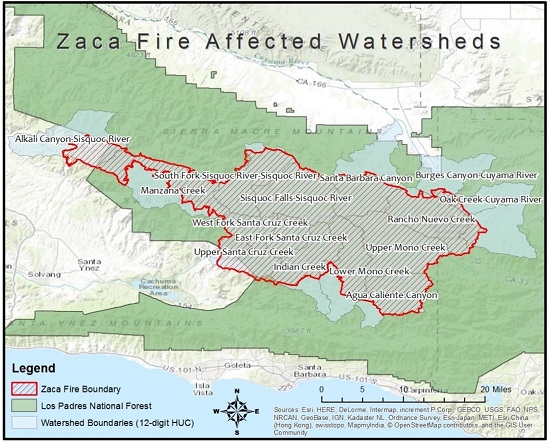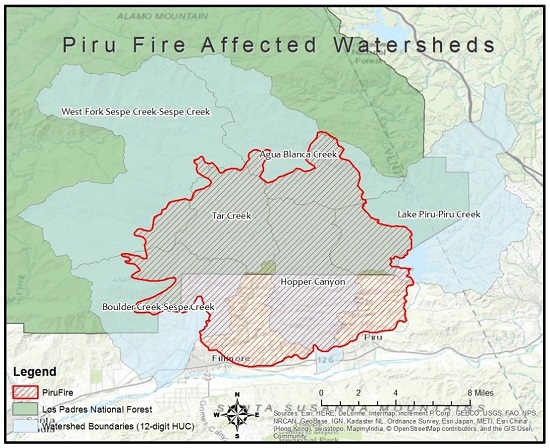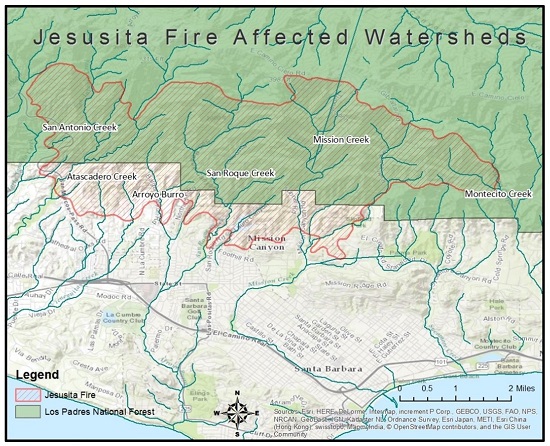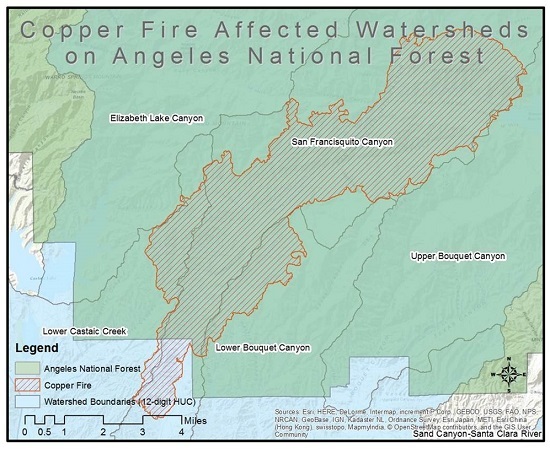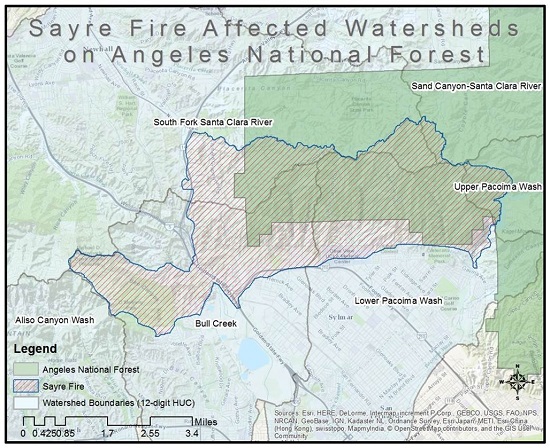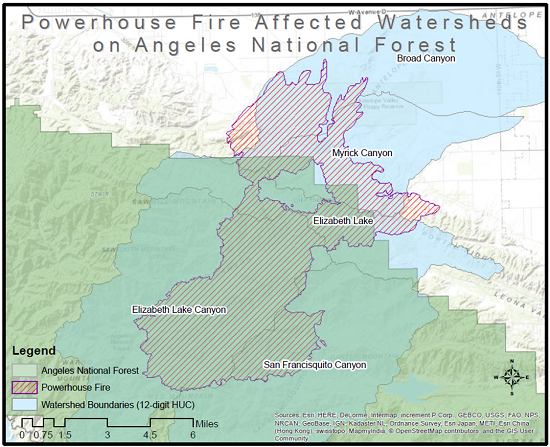Southern California Forests and Watersheds - Wildfires Restoration 2021 Request For Proposals
Pre-Proposal Due Date: Wednesday, February 17, 2021 by 8:59 PM Pacific Time
Full Proposal Due Date: Tuesday, April 6, 2021 by 8:59 PM Pacific Time
OVERVIEW
The National Fish and Wildlife Foundation (NFWF), in close cooperation with its U.S. Forest Service (USFS) federal partners, the Los Padres National Forest (LPNF) and Angeles National Forest (ANF), as well as the Arbor Day Foundation (ADF) are pleased to announce the Southern California Forests and Watersheds – Wildfires Restoration Program (Program) for the recovery of lands and watersheds degraded from the influences of past wildfire events. USFS funds for this opportunity are applicable only to Federal lands affected by the following wildfires:
Los Padres National Forest: Zaca (2007), Piru (2003), and Jesusita (2009) fires
Angeles National Forest: Copper (2002), Sayre (2008), and Powerhouse (2013) fires.
The Southern California Forests and Watersheds Program has approximately $6.3 million available for this 2021 funding cycle, with the following amounts available for each fire:
Los Padres National Forest – Zaca $600K, Piru $500K, Jesusita $900K
Angeles National Forest – Copper $3M, Sayre $400K, Powerhouse $900K.
The major goals of this competitive grant program are to:
- Increase the pace and scale of restoration to address impacts from these fires;
- Provide sustainable and lasting ecological benefits to the forest;
- Engage in efficient, strategic, and innovative solutions to improve forest health and resilience;
- Encourage ‘shared-stewardship’ of USFS lands through expanded partnership and cooperation.
In addition, the 2021 Southern California Forests and Watersheds - Wildfire Restoration Program includes additional funding from the Arbor Day Foundation to support wildfire restoration and recovery. Approximately, $1.2 million are available to help fund activities specific to the post-wildfire restoration of forests and woodlands throughout Southern California. Primary focus of these funds is intended for tree propagation, seedling purchase, and on-the-ground restoration; however, complementary activities (e.g. nursery capacity building, seed collection/storage, post-fire site clearing/preparation, etc.) may be considered. Unlike the USFS funding above, ADF funding is NOT LIMITED to any particular jurisdictional boundaries or specific wildfire events.
GEOGRAPHIC FOCUS (USFS Wildfire Recovery)
This grant program focuses on watersheds and ecosystems affected by the fires identified above. Figures 1 and 2 illustrate the boundaries of those fires in the context of the Los Padres and Angeles National Forests, with more detailed maps identifying specific watersheds and priority locations that were impacted by these fires included at the end of this RFP. Project activities are eligible in any of the affected watersheds, provided the activity has a direct nexus to a need resulting from, or exacerbated by, one or more of the fires included for funding in this RFP. Grant funds must support projects that occur on Federal Lands only, complementary actions that occur on non-Forest Service land may be incorporated for matching value, but are not eligible for funding. Activities related to wildfire events other than those identified above are not eligible for this particular funding opportunity.
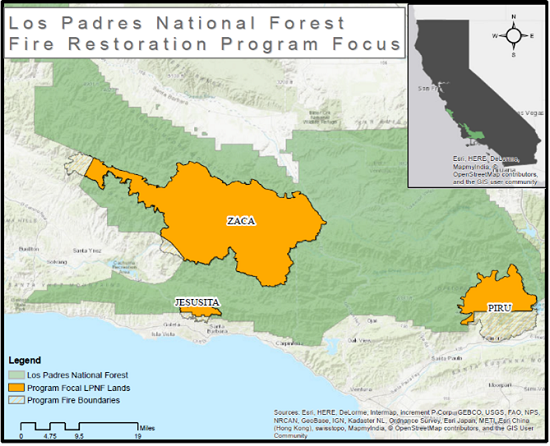
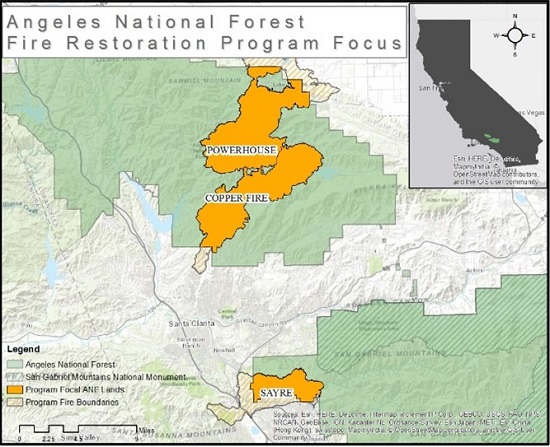
Figures 1 & 2. Fires eligible for current restoration funding
PROGRAM PRIORITIES
Grant funding will be awarded to planning and/or implementation projects designed to advance fire recovery and improve ecological resilience on the LPNF and ANF. To be eligible for funding:
- Projects must conduct, or inform, the improvement, protection, or rehabilitation of ecosystems and watersheds for and on Federal National Forest System lands impacted by these fires.
- Project proposals must clearly describe the need for the proposed project as rendered necessary by the impacts of the fire where activities are focused.
- Project goals, objectives, and activities must provide a direct and practical contribution toward one or more General Programmatic Strategies (described below), with a strong preference to on-the-ground, implementable actions.
Competitive proposals will address at least one of the programmatic strategies described below. Eligible projects include a wide scope of potential activities across a variety of strategies and focus. Further details related to the goals and priorities of this fire recovery program are described within the National Fish and Wildlife Foundation’s Los Padres National Forest Business Plan (August 2016) and Angeles National Forest – Copper, Ranch, and Sayre Fires Restoration Strategy (2017).
In addition to the general programmatic strategies, the USFS has identified specific high priority needs for immediate action. High priority projects are described in detail in the RFP Appendix. Applicants are encouraged to consider addressing projects from the RFP Appendix when and where appropriate to your organization’s interests and expertise. However, this grant program welcomes any project proposals that seek practical and innovative approaches to landscape and species recovery and management as it relates to the fires addressed through this program.
General Programmatic Strategies
Watershed Restoration and Management
- Improve hydrologic connectivity and aquatic organism passage.
- Remove aquatic invasive species threatening aquatic habitat or sensitive species.
- Reduce pollutant loading and restore and/or enhance water quality and instream flow.
- Create, maintain, or improve in-stream, riparian, or wetland habitat.
Forest and Upland Restoration and Management
- Evaluate forest ecosystems, such as oak woodlands, native grasslands, upland conifer, and chaparral and coastal sage scrub and develop effective treatment/restoration actions.
- Harvest native seed and/or propagate native plants, and maintain, improve, or restore native ecosystems communities and resilient landscapes.
- Manage and improve ecological resilience to future fire through invasive vegetation treatment, fuel break maintenance, vegetation community age-class structure restoration, and strategic fuels reduction.
Species Management
- Evaluate and/or restore or improve conditions relative to a specific species, ecologicial community, or habitat type. Species of interest include, but are not limited to big cone Douglas fir, steelhead, unarmored three-spine stickleback, California red-legged frog, arroyo toad, southwestern willow flycatcher, and California condor.
- Inform decisions and actions related to management and recovery of species/natural communities within fire affected watersheds.
Public Use Engagement and Management
- Evaluate conditions and provide management recommendations for trails, roads, campsites, fuel breaks, and other areas affected by fire or fire suppression activity.
- Maintain, improve, and restore trails, roads, campsites, and other areas affected by fire or fire suppression activity.
- Restore areas impacted by non-USFS system/user-created trails, roads, or campsites.
- Develop educational and engagement opportunities to interpret the natural and cultural history on USFS land; integrate the role, impact, and history of fire in these Forest landscapes.
Working with the Forest Service
NFWF and the USFS welcome and encourage all proposals that meet the goals and priorities of this program. As this program solicits projects that will occur upon, and to the benefit of, USFS land, it is important to note that the USFS may have specific policies, protocols, and requirements related to some or all project activities that must be met before they can be executed. These requirements will differ depending on the project proposed. Examples of such incorporation may include explicit compliance with all pertinent laws and regulations (e.g. NEPA), integration of performance standards, adoption of specific best management practices or design standards (such as stated in the Land Management Plan and other USFS Management Documents), adherence to data deliverable/reporting formats, etc. In certain cases, not all requirements will be known at the time of application, however your proposal will benefit from identifying as many of these conditions as possible, in order to develop the most appropriate estimates of your project scope, timeline, and budget.
Please note, successful grant recipients are not considered volunteers to the Forest Service and are therefore not subject to Forest Service Volunteer Agreements and the benefits and restrictions those agreements provide. Grantees are ultimately responsible for the execution of their project and assume all legal liability for their actions and the well-being of their participants (which may themselves be volunteers to your organization/project).
NFWF acknowledges the many influencing factors that may affect project timelines and success, including occasional limitations to USFS staff availability, unpredictable and limiting weather and wildfire conditions, restrictive periods of operation, etc. Applicants should identify and understand potential factors and dependencies, and prepare to adapt as needed to ensure project success.
Applicants are strongly encouraged to contact NFWF Program Manager, Jim Bond, prior to submitting your proposal to discuss ideas, seek relevant project-related information and contacts, and ensure applicability of project proposals with Program objectives and needs of NFWF and the USFS.
PROJECT METRICS
To better gauge progress on individual grants and to ensure greater consistency of project data provided by multiple grants, the Southern California Forests and Watersheds Program has a list of metrics in Easygrants (NFWF’s web-based application platform) for applicants to choose from for future NFWF reporting. We ask that applicants select only the most relevant metrics from this list for their project (Table 1). Where multiple metrics could apply for the same activity, select the metric that is most representative of the outcome. Avoid using the same value across multiple metrics unless they are clearly discernable from each other. For instance, if your project conducts 50 acres of invasive weed removal, only count the activity under ‘Habitat Restoration – Removal of Invasives – acres restored’. If your project conducts 50 acres of invasive weed removal and installs and maintains native plants after the invasive removal, you may include a second metric of ‘Habitat Restoration – Land Restoration – Acres Restored. If you think an applicable metric has not been provided, please contact NFWF’s Jim Bond at jim.bond@nfwf.org to discuss acceptable alternatives.
Project metrics should account for those activities that will be conducted with NFWF funding, and associated match, during the project’s period of performance. In addition to the EZG metrics, USFS may request additional or more detailed reporting.
Table 1. Program Metrics
| Project Activity | Recommended Metric | Additional Guidance |
|---|---|---|
| Volunteer Participation | # volunteers participating |
Enter the number of volunteers participating in projects. |
| Outreach/Education/Technical Assistance | # people reached |
Enter the number of people reached by outreach, training, or technical assistance activities. |
| Research | # studies completed to inform mgmt |
Enter the number of studies completed whose findings are used to adapt mgmt/inform mgmt. decisions. |
| Research | Acres assessed for improved management |
Enter the number of acres assessed. |
| Restoration Planning/Design/Permitting | # E&D plans developed |
Enter the number of Engineering and Design plans, and/or compliance documents developed. Generally there will be 1 per milestone, e.g., 10% design, 30% design, sampling design plan, final report/data compilation. |
| Removal of Invasives | Acres restored |
Enter the number of acres restored. |
| Instream Restoration | Miles restored |
Enter the number of miles restored. |
| Fish Passage Improvements | # passage barriers rectified |
In the notes section of this metric please indicate the number and type of barrier is being removed (i.e. dam, culvert, etc.). |
| Fish Passage Improvements | Miles of stream opened |
Enter the number of miles of stream opened to fish passage. |
| Riparian Restoration | Acres restored |
Enter the number of acres restored. |
| Wetland Restoration | Acres restored |
Enter the number of acres restored. |
| Land Restoration | Acres restored |
Enter acres restored through the re-establishment (planting) of native vegetation or changes to the landscape that promote improved ecological function and natural ecosystems. If the project to be undertaken focuses primarily on Invasive Vegetation Management actions use “Removal of Invasives – Acres Restored“. If project to be undertaken focuses primarily on Fuels Reduction actions (thinning, limbing, tree removal, etc.) use “Improved Management Practices – Acres under Improved Management”. If the project is a combination of these actions, use those metrics which apply to each of the activities and then enter the representative acres. For example, a 10 acres project site may include 10 acres of “Removal of Invasives” and 5 acres of planting under “Land Restoration”. |
| Green Infrastructure | Miles of trails developed/improved |
Enter the number of miles of trails developed or improved. |
| BMP Implementation for Road Improvements | Miles of road improved |
Enter the number of miles of road improved. |
| Erosion control | Lbs. of sediment avoided |
Enter the amount of sediment prevented from entering the system annually. |
| Green Infrastructure | # trees planted |
Enter the number of trees planted. |
| Plant Cultivation | # seedlings propagated |
Enter the number of seedlings propagated. |
| Seed Harvesting | Lbs. of seed harvested |
Enter the number of pounds of seeds collected, may be estimated from bushels of cones collected. |
| Improved Management Practices | Acres under improved management |
Enter the number of acres improved under land management practices on public lands. This metric refers to on-the-ground fuels and vegetation management treatments such as thinning, limbing, tree removal, etc. |
ELIGIBILITY
Eligible and Ineligible Entities
- Eligible applicants include non-profit 501(c) organizations, state, local, and municipal government agencies, Tribal governments and organizations, educational institutions, and eligible federal agencies (research-based: USGS or USFS Research Station).
- Ineligible applicants include businesses, unincorporated individuals, and international organizations.
Ineligible Uses of Grant Funds
- Equipment: Applicants are encouraged to rent equipment where possible and cost-effective or use matching funds to make those purchases. NFWF acknowledges, however, that some projects may only be completed using NFWF funds to procure equipment. If this applies to your project, please contact the program staff listed in this RFP to discuss options.
- Federal funds and matching contributions may not be used to procure or obtain equipment, services, or systems (including entering into or renewing a contract) that uses telecommunications equipment or services produced by Huawei Technologies Company or ZTE Corporation (or any subsidiary or affiliate of such entities) as a substantial or essential component, or as critical technology of any system. Refer to Public Law 115-232, section 889 for additional information.
- NFWF funds and matching contributions may not be used to support political advocacy, fundraising, lobbying, litigation, terrorist activities or Foreign Corrupt Practices Act violations.
- NFWF funds may not be used to support ongoing efforts to comply with legal requirements, including permit conditions, mitigation and settlement agreements. However, grant funds may be used to support projects that enhance or improve upon existing baseline compliance efforts.
FUNDING AVAILABILITY AND MATCH
The Southern California Forests and Watersheds Program has approximately $7.5 million available for this 2021 funding cycle, with the following amounts available for each fire:
Los Padres National Forest – Zaca Fire $600K, Piru Fire $500K, Jesusita Fire $900K
Angeles National Forest – Copper Fire $3M, Sayre Fire $400K, Powerhouse Fire $900K
Arbor Day Foundation - $1.2M (Not specific to a wildfire or federal land)
- Grant award amounts are expected to range from $50,000 to $500,000 per project. Past grant awards typically ranged from $100,000 to $200,000.
- Proposals requesting funds in outside of the expected range may be considered, however your proposal should include clear justification. Applicants who intend to request an amount out of the expected range are encouraged to discuss your proposal with NFWF Program Manager prior to submittal.
- Matching funds are required and will be a factor in the proposal evaluation.
- Projects are expected to provide at least 50% non-federal match to be competitive.
- Highly competitive projects will meet or exceed a 100% non-federal match.
- Proposals not meeting the match expectations may be considered on a limited case-by-case basis and are still encouraged to apply. Applicants who don’t anticipate meeting the match requirements are encouraged to discuss your proposal with NFWF Program Manager prior to submittal.
- Matching contributions must be necessary and reasonable for accomplishment of the project. Match may include non-federal cash, in-kind contributions of staff and volunteer time, work performed, materials and services donated, or other tangible contributions to the project objectives and outcomes. Please review the NFWF Indirect Cost Policy for Applicants for specific information about using indirect costs as match.
- All project costs, including matching contributions, must be incurred within the project period of performance. Generally, projects awarded through this funding opportunity are expected to be completed within 24 months of the grant award, however exceptions may be given depending on need and activities proposed. Some larger-scale, longer duration projects may warrant either an extended period of performance, or developing the project into distinct phases, to be funded over separate funding cycles. Large-scale projects that require funding cycles should include a request and justification in their proposal. For more guidance on project start and end dates, see the Applicant Tip Sheet.
- Applicants may submit more than one proposal, but proposals should be specific to individual Forests (i.e. if you want to submit proposals for ANF and LPNF then you should submit separate proposals for each National Forest).
EVALUATION CRITERIA
All proposals will be screened for relevance, accuracy, completeness and compliance with NFWF and funding source policies. In addition, please note that all projects through this funding opportunity are solicited to provide support to the USFS with their fire recovery and related land and resource management needs. As such, project outcomes should provide a direct and practical contribution to either on-the-ground implementation to improve conditions on USFS land, or, the development of data, analysis, design, and recommendations that will inform USFS decisions and lead to action in the foreseeable future. USFS Proposals will be evaluated in consideration of the following criteria (some criteria may not be applicable to your project):
Program Goals and Priorities - The proposal is consistent with the Program goals as described in this RFP and associated Program Business Plan and Restoration Strategy, and has specific, quantifiable performance metrics to evaluate project success. The project deliverable(s) clearly contribute to a practical advancement toward those goals.
Technical Merit - Project is technically sound and feasible, and the proposal sets forth a clear, logical and achievable work plan and timeline. Project engages appropriate technical experts throughout project planning, design and implementation to ensure activities are technically-sound and feasible.
Cost-Effectiveness – Project includes a cost-effective budget that balances performance risk and efficient use of funds. Cost-effectiveness evaluation may include, but is not limited to, an assessment of either or both direct and indirect costs in the proposed budget. The federal government has determined that a de minimis 10% indirect rate is an acceptable minimum for organizations without a NICRA, as such NFWF reserves the right to scrutinize ALL proposals with indirect rates above 10% for cost-effectiveness.
Transferability - Project has potential/expectation to transfer lessons learned to a broader scale, particularly in Southern California, and/or to be integrated into regional programs and policies.
Communication - Project includes a detailed plan to communicate information about the project to appropriate audiences.
Funding Need – Project establishes a clear need for the funds being requested, and demonstrates that activities would not move forward absent funding.
Conservation Plan and Context – The project advances an existing conservation plan or strategy.
Past Success - Applicant has a proven track record of success in implementing conservation practices with specific, measurable results.
Long-term Sustainability – Project will be maintained to ensure benefits are achieved and sustained over time. This should include how future funding will be secured to implement necessary long-term monitoring and maintenance activities.
Monitoring and Project Documentation - Project includes a plan for monitoring progress during and after the proposed project period to track project success and adaptively address new challenges and opportunities as they arise. All projects will be expected to document and deliver relevant geospatial data associated with activities performed, as part of the project reporting information provided to NFWF and USFS. Geospatial information will be consistent with established USFS geospatial data standards and format (e.g. data dictionaries, metadata formats).
Partnership - An appropriate partnership exists to implement the project and the project is supported by a strong local partnership that leverages additional funds and expertise and will sustain it after the life of the grant. Identify proposed partners if known (including potential or contemplated subawards to third party subrecipients), the roles they will play in implementing the project, and how this project will build new or enhance existing partnerships. (Note: a project partner is any local community, non-profit organization, tribe, and/or local, state, and federal government agency that contributes to the project in a substantial way and is closely involved in the completion of the project.)
Consistency with Overarching Federal or State Conservation Initiatives - If applicable, proposals may also address goals, priorities, and recommendations in context with broader federal, state, or regional conservation plans or strategies. Proposals should describe specifically how the project aligns with complementary conservation initiatives, and reference appropriate documentation.
OTHER
Budget – Costs are allowable, reasonable and budgeted in accordance with NFWF’s Budget Instructions cost categories. Federally-funded projects must be in compliance with OMB Uniform Guidance as applicable.
Matching Contributions – Matching Contributions consist of cash, contributed goods and services, volunteer hours, and/or property raised and spent for the Project during the Period of Performance. Larger match ratios and matching fund contributions from a diversity of partners are encouraged and will be more competitive during application review.
Procurement – If the applicant chooses to specifically identify proposed Contractor(s) for Services, an award by NFWF to the applicant does not constitute NFWF’s express written authorization for the applicant to procure such specific services noncompetitively. When procuring goods and services, NFWF recipients must follow documented procurement procedures which reflect applicable laws and regulations.
Publicity and Acknowledgement of Support – Award recipients will be required to grant NFWF the right and authority to publicize the project and NFWF’s financial support for the grant in press releases, publications and other public communications. Recipients may also be asked by NFWF to provide high-resolution (minimum 300 dpi) photographs depicting the project.
Receiving Award Funds – Award payments are primarily reimbursable. Projects may request funds for reimbursement at any time after completing a signed agreement with NFWF. A request for advance of funds must be due to imminent need of expenditure and must detail how the funds will be used and provide justification and a timeline for expected disbursement.
Compliance Requirements – Projects selected may be subject to requirements under the National Environmental Policy Act, Endangered Species Act (state and federal), and National Historic Preservation Act. Documentation of compliance with these regulations must be approved prior to initiating activities that disturb or alter habitat or other features of the project site(s). Applicants should budget time and resources to obtain needed approvals. As may be applicable, successful applicants may be required to comply with additional Federal, state or local requirements and obtain all necessary permits and clearances.
Permits – Successful applicants will be required to provide sufficient documentation that the project expects to receive or has received all necessary permits and clearances to comply with any Federal, state or local requirements. NFWF strongly encourages applicants to conduct permit pre-application meetings with the appropriate administering agencies prior to submitting their proposal. In some cases, if a permit pre-application meeting has not been completed, NFWF may require successful applicants to complete such a meeting prior to grant award.
Federal Funding – Federally funded projects must operate in compliance with the OMB Uniform Guidance as applicable to the applicant. The availability of federal funds estimated in this solicitation is contingent upon the federal appropriations process. Funding decisions will be made based on level of funding and timing of when it is received by NFWF.
TIMELINE
Dates are subject to change. Please check the program page of the NFWF website for the most current dates and information at www.nfwf.org/socal.
| Applicant Webinar | January 21, 2021 at 2:00 PM Pacific Time | |
| Pre-Proposal Due Date | February 17, 2021 by 8:59 PM Pacific Time | |
| Full Proposal Invitations | March 1, 2021 | |
| Full Proposal Due Date | April 6, 2021 by 8:59 PM Pacific Time | |
| Review Period | April - June 2021 | |
| Awards Announced | Mid-August 2021 |
HOW TO APPLY
All application materials must be submitted online through National Fish and Wildlife Foundation’s Easygrants system.
- Go to https://easygrants.nfwf.org to register in our Easygrants online system. New users to the system will be prompted to register before starting the application (if you already are a registered user, use your existing login). Enter your applicant information. Please disable the pop-up blocker on your internet browser prior to beginning the application process.
- Once on your homepage, click the “Apply for Funding” button and select this RFP’s “Funding Opportunity” from the list of options.
- Follow the instructions in Easygrants to complete your application. Once an application has been started, it may be saved and returned to at a later time for completion and submission.
APPLICATION ASSISTANCE
An Applicant Tip Sheet is available for quick reference while you are working through your application and can be downloaded here.
Additional information to support the application process can be accessed on the NFWF’s Applicant Information page.
For more information or questions about this RFP, please contact:
Jim Bond
Senior Manager, Southern California Forests
Jim.Bond@nfwf.org
415-243-3107
Jessica Perla
Programs Coordinator, Western Regional Programs
Jessica.Perla@nfwf.org
202-595-2422
For issues or assistance with our online Easygrants system, please contact:
Easygrants Helpdesk
Email: Easygrants@nfwf.org
Voicemail: 202-595-2497
Hours: 9:00 am to 5:00 pm ET, Monday-Friday.
Include: your name, proposal ID #, e-mail address, phone number, program you are applying to, and a description of the issue.
FIRE AFFECTED WATERSHEDS ELIGIBLE FOR PROJECT ACTIVITIES
